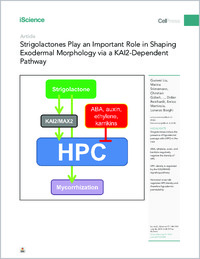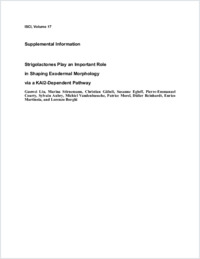Strigolactones play an important role in shaping exodermal morphology via a KAI2-dependent pathway
- Liu, Guowei Department of Plant and Microbial Biology, University of Zurich, Switzerland
- Stirnemann, Marina Department of Plant and Microbial Biology, University of Zurich, Switzerland
- Gübeli, Christian Department of Plant and Microbial Biology, University of Zurich, Switzerland
- Egloff, Susanne Department of Plant and Microbial Biology, University of Zurich, Switzerland
- Courty, Pierre-Emmanuel Laboratoire Reproduction et Développement des Plantes, Univ Lyon, France
- Aubry, Sylvain Department of Plant and Microbial Biology, University of Zurich, Switzerland
- Vandenbussche, Michiel Department of Reproduction and Plant Development, Lyon, France
- Morel, Patrice Department of Reproduction and Plant Development, Lyon, France
- Reinhardt, Didier Department of Biology, University of Fribourg, Switzerland
- Martinoia, Enrico Department of Plant and Microbial Biology, University of Zurich, Switzerland
- Borghi, Lorenzo Department of Plant and Microbial Biology, University of Zurich, Switzerland
-
26.07.2019
Published in:
- iScience. - 2019, vol. 17, p. 144–154
English
The majority of land plants have two suberized root barriers: the endodermis and the hypodermis (exodermis). Both barriers bear non-suberized passage cells that are thought to regulate water and nutrient exchange between the root and the soil. We learned a lot about endodermal passage cells, whereas our knowledge on hypodermal passage cells (HPCs) is still very scarce. Here we report on factors regulating the HPC number in Petunia roots. Strigolactones exhibit a positive effect, whereas supply of abscisic acid (ABA), ethylene, and auxin result in a strong reduction of the HPC number. Unexpectedly the strigolactone signaling mutant d14/dad2 showed significantly higher HPC numbers than the wild-type. In contrast, its mutant counterpart max2 of the heterodimeric receptor DAD2/MAX2 displayed a significant decrease in HPC number. A mutation in the Petunia karrikin sensor KAI2 exhibits drastically decreased HPC amounts, supporting the hypothesis that the dimeric KAI2/MAX2 receptor is central in determining the HPC number.
- Faculty
- Faculté des sciences et de médecine
- Department
- Département de Biologie
- Language
-
- English
- Classification
- Biological sciences
- License
- License undefined
- Identifiers
-
- RERO DOC 326939
- DOI 10.1016/j.isci.2019.06.024
- Persistent URL
- https://folia.unifr.ch/unifr/documents/307962
Other files
Statistics
Document views: 52
File downloads:
- gei_spi.pdf: 186
- gei_spi_sm.pdf: 139
- gei_spi_sm.txt: 35


